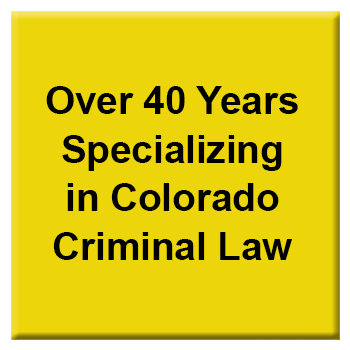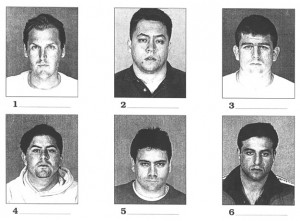






Colorado Criminal Lawyer Series – He’s The One – Lineups and Show Ups In Colorado
By H. Michael Steinberg – Colorado Criminal Defense Lawyer – Email the Author at [email protected]
Colorado Criminal Lawyer Series – He’s The One – Lineups and Show Ups In Colorado -Identifications in court – if they are strong – can have devastating results. Understanding how ID’s are developed and “made” by law enforcement – how they can be attacked – and even suppressed – maybe a key to the successful defense of a Colorado criminal case.
Bottom line – “A defendant is denied due process when an in-court identification is based upon an out-of-court identification which is so suggestive as to render the in-court identification unreliable.”
Colorado’s Lineups and Showups
Attacking the identification of the accused before and at trial is critical to the defense of a criminal case. The moment that an eyewitness points to the defendant and says ” that’s him – he did this to me…” the jury is listening closely and the impact is clear.
The inherent weaknesses of courtroom identification are well known and well understood by those in the fields of social science as well as the lawyers and judges who hear criminal cases everyday.
Eye witnesses are often terribly mistaken and their mistakes are many times the result of a poorly conducted lineup or showup procedure that was either intentionally or inadvertently structured in such a way as to either induce or somehow prompt an eyewitness to make an identification of the suspect – that person who is ultimately criminally charged and becomes the defendant.
The United States Supreme Court has said this about influence of the identification of the defendant on the jury’s perception of guilt :
[T]he influence of improper suggestion upon identifying witnesses probably accounts for more miscarriages of justice than any other single factor—perhaps it is responsible for more such errors than all other factors combined.
There are important procedures that have been developed over time that have been designed to minimize the inherent suggestiveness of lineups and – or showups and – when they are used – will tend to maximize the reliability of these procedures.
Fighting Identification Evidence In Colorado Criminal Cases
In any given criminal trial where identification is an issue – the Defendant should contend that it would be error for the Court to admit into evidence (if a lineup or showup was used) these suggestive and unreliable procedures leading to “identification” evidence – such as an in court identification of the defendant.
Known as the issue of the admissibility of “out-of-court identifications,” a defendant has the burden of showing that the identification procedure used to identify the accused was impermissibly suggestive. If the defendant meets this burden, the burden of proof then shifts to the prosecution to show that the identification was nevertheless reliable under the totality of the circumstances.
The Test For Reliability Of An Out of Court Identification
To determine the reliability of an Out of Court Identification – the court considers:
(1) the opportunity of the witness to view the criminal at the time of the crime,
(2) the witness’s degree of attention,
(3) the accuracy of the witness’s prior description of the criminal,
(4) the level of certainty demonstrated by the witness at the confrontation, and
(5) the length of time between the crime and the confrontation.
The trial court’s ruling on pretrial identification procedures is a mixed question of law and fact.
“A defendant is denied due process of the law when an in-court identification is based on an out-of-court identification that is so unnecessarily suggestive as to render the in-court identification unreliable.”
What About The Suggestiveness Of The In Court Identification?
It is extraordinarily rare for a judge to suppress an in court identification for being “too suggestive” – as historically an in court identification at trial has always been allowed.
Unless a “very substantial likelihood of irreparable misidentification exists, identification evidence goes to the jury to determine what weight to assign the evidence.”
BUT – after the application of the “Monroe Factors” – a Court may find that the danger of irreparable misidentification may actually exist. Once again – in determining whether the witness’s in-court identification is based upon the witness’s prior independent observations, a Court considers the same 5 factors – listed above –
They bear repeating here:
(1) the opportunity of the witness to view the criminal at the time in question;
(2) the witness’s degree of attention;
(3) the accuracy of any prior description of the criminal by the witness;
(4) the level of certainty demonstrated by the witness at the later confrontation; and
(5) the time that has elapsed between the crime and the confrontation.
The typical in court identification of a defendant is the same as a one-on-one showup and is clearly and “undoubtedly suggestive.” However in court identifications will be permitted in almost every case.. Unless the “corrupting effect of the suggestive identification under the totality of the circumstances suggests “a very substantial likelihood of misidentification.”
Types of Lineups and Showups In Colorado
There are basically four types of lineups and two types of showups in law enfocement.
The Live Lineup
The most well known “lineup” is the live or “corporeal” lineup. In this lineup the suspect is displayed to the witness in the company of five or more people who are intended to closely ressemble him. The non suspect persons are called “fillers” or “foils.”
These lineups usually occur when the suspect is in custody for the crime or under investigation for another crime. When the suspect is not custody, the procedure most often followed is the photo lineup.
The Recorded Lineup
Here officers put together a live lineup that is recorded and later shown to the witnesses.
This procedure is most often used when a witness cannot attend the live version of the physical lineup.
The Most Common Lineup – the Photographic Lineup
Here a witness is shown photographs of the suspect and the fillers – the fillers are usually taken from booking or Department of Motor Vehicle photos. The suspect had not yet been arrested. A photo lineup may also be necessary if the suspect has changed how he looks after the crime occurred.
The Law Of Colorado Photographic Lineups
Colorado applies a two part test to determine the admissibility of out-of-court photographic identifications.
Part I – The court considers whether the defendant has demonstrated that the photo array used was impermissibly suggestive. If the defendant cannot meet this burden of proof, the inquiry ends there.
Part II – If the defendant meets his burden of proof, the state of Colorado must then show that the photo array was nevertheless reliable under the totality of the circumstances.
The relevant factors from which a Court determines whether a pretrial photographic identification procedure is impermissibly suggestive include:
-
the size of the array, (6 or more photos)
-
the manner of its presentation by the officers, (see below on this issue)
-
and the details of the photographs themselves. (Need not be exact replicas of the defendant but should be matched by race, approximate age, facial hair, and a number of other characteristics. – if unique features of the defendant exist – that directly relate to an important identification “factor” – the array may be impermissibly suggestive.)
If a court finds that an array is impermissibly suggestive, then it determines whether, under the totality of the circumstances, the state of Colorado can demonstrate that the identification was nevertheless still “reliable.”
Here is what the Colorado Court Of Appeals has said:
If the number of photographs is not so small to make the array impermissibly suggestive, and there is nothing suggestive in the manner of the official’s presentation of the array, then the remaining consideration is whether the photographs in the array are so limited that the defendant is the only one to match the witness’s description of the perpetrator.”
The Photo Collection
When there is no specific suspect – If officers have no suspect, or an “unsub” and there is known evidence to place the alleged perpetrator into a certain category – a witness may be shown photos of members of that group – these include – gang books, sexual offenders – or even school yearbooks.
The Voice-only Lineup
Used when the witness heard the perpetrator speak, but did not see him.
In the “Field” Showups
Unfortunately – a procedure permitted by law is the pretrial identification procedure in the “field” known as a showup. Here a suspect is usually displayed in the street – in handcuffs – alone – with no “fillers” and then asked “Is this him?”
This is the most egregious of all pre-trial identification procedures as it is the most highly suggestive. The reason the courts give for permitting the show up is to limit the amount of time a suspect is in custody and to quickly confirm or dispel the suspicion that this person is the perpetrator.
Field showups are inherently suggestive because the potential identification witness sees one single person.
One thing to note – a suspect cannot be transported to the location of the identification witness – the police must transport the witness to the location of the suspect unless there is good cause to do otherwise.
The Confirmatory Showup
Another form of show up is the so called “confirmatory” showup where the arrested suspect is shown to the witnesses without any fillers – live or by photograph. This procedure – like all showups – is unfairly highly suggestive.
The Analysis Mapped Out:
1. Was the lineup unduly suggestive? If No: The ID testimony will be admissible. If yes go to 2.
2 Despite such suggestiveness, was the witness’s identification of the defendant trustworthy? If No: The lineup ID is suppressed. If Yes: The lineup results will be admissible.
If a lineup ID is suppressed by a judge, then the identification witness will not be given an opportunity to identify the defendant in court unless prosecutors prove “by clear and convincing evidence that the in-court identification is based upon observations of the suspect other than the lineup identification.”
What Does Suggestive Really Mean? – Fighting “Suggestiveness” In Colorado Identification Cases
What then is too much “suggestiveness? Under Colorado law – onen way a lineup or showup is too “suggestive” if it was conducted in a manner that would have communicated to the witness that the suspect was, in fact, the perpetrator. In short the police must wither wittingly or unwittingly, initiate the unduly suggestive procedure. If the police acted in such a way as to make a lineup or showup unduly suggestive, it does not matter that they did not intend to do so.
Examples:
The Voice-only Lineup – If the voices are not similar in tone, generic cialis legal pitch, volume and accent, so as to be unfair or impermissibly suggestive, the voice lineup could be corrupted.
The Lineup Position – Where the suspect’s photograph is placed can be overly suggestive.
The Number of Fillers – Must include at least five. The more fillers the less suggestiveness; better yet – gang books, mug books, sexual assault registries, or school year books.
Multiple Lineup Appearances – If a suspect is placed in more than one lineup shown to the same witness or witnesses – unless there is a a legitimate need for multiple lineup appearances, this may render an identification unduly suggestive.
The Suspect Somehow Directs Attention to Himself – If a suspect himself says or does something to draw attention to himself, he does not benefit from the suggestiveness of his conduct. The corrupting effect must be done by law enforcement.
Providing Suggestive Information – The police must not say anything to the witness that could be reasonably interpreted as directing attention to the suspect.
Implying a Suspect or Perpetrator Is in Lineup – The police should not tell a witness that they have arrested someone who is a “suspect” or that the suspected perpetrator is in the lineup…such as “Which one of these guys did it?” While that alone is not unduly suggestive – it can be used with other factors to help the defendant meet his burden of proof.
Another Witness Made ID’D One Of These Guys – When another witness identifieds someone in a lineup, the police should keep this fact confidential.
The Cautionary Instruction – The Pre-Showing” Advisement
This gives an impartial advisement to the witness that the perpetrator may not be in the lineup.
Here are sample advisements
Advisements for Lineups
“The perpetrator may or may not be in the lineup. Do not assume that we have identified the perpetrator merely because we are asking you to attend a lineup. You are not obligated to identify anyone. Do not discuss your case with other witnesses or anyone else in the room. .. Do not call out a person’s number or do anything that might indicate to others that you have identified someone. .. If you want to have a certain person say or do something, make your request to the officer conducting the lineup. All people in the line will then be asked to say or do the same thing. Our investigation in this case will continue regardless of whether you identify or do not identify anyone.
Advisements for Showups ..
“Do not assume that the person you will be seeing is the perpetrator merely because we are asking you to look at him [or because he is handcuffed] [or because he is sitting in a patrol car]. .. Do not speak with the other witnesses who will be going with us. .. When we arrive, do not say anything in the presence of other witnesses that would indicate you did or did not recognize someone. You will be questioned separately. .. Our investigation in this case will continue regardless of whether you identify or do not identify anyone.”
Never – Ever – Ever Allow – “You Picked the Right One”
The police should never inform a witness that he picked the “right” person in a lineup and this is especially true if the ID was weak The police should also not inform the witness that there exists additional evidence of guilt.
Witnesses Should Be Separated
Whenever two or more witnesses will be viewing a lineup or showup, it would be inherently suggestive if one of them were to hear another witness identify the suspect.
the court ruled that one of the circumstances that rendered a lineup “eminently fair” was that the witnesses “were separated, told not to talk with each other, and to designate their identifications by writing the suspect’s number on a card provided them.”
Finally Here Are the Recommendations By A National Organization -The CCJA – (The Center for Criminal Justice Advocacy) – On How To Properly Conduct Identification Procedures:
Double Blind Procedures
1. Double-blind identification procedures should be utilized whenever practicable, so the person displaying photos in a photo spread or operating a lineup is not aware of the identity of the actual suspect. When double-blind administration is not practicable, other double-blind alternatives should be considered.
2. When double-blind procedures are utilized, the use of sequential presentation of photos and line-up participants is preferred, so the witness is only presented with one person at a time. Photos or subjects should be presented in random order, and witnesses should be instructed to say yes, no or unsure as to each photo or participant. Sequential procedures should not be used where double-blind administration is not available.
Showups
3. A single subject show-up should not be used if there is probable cause to arrest the suspect. The suggestiveness of show-ups should be minimized by documenting a description of the perpetrator prior to the show-up, transporting the witness to the location of the suspect, and where there are multiple witnesses they should be separated, and lineups or photo spreads should be used for remaining witnesses after an identification is obtained from one witness.
4. All witnesses should be instructed that a suspect may or may not be in a photo spread, lineup or show-up, and they should be assured that an identification or failure to make an identification will not end the investigation.
Live Linups
5. Live lineup procedures and photo displays should be preserved on video tape, or audio tape when video is not practicable. When video taping is not practicable, a still photo should be taken of a live lineup. Police acquisition of necessary video equipment should be supported by legislative appropriations.
6. At the conclusion of a lineup, photo presentation, or show-up, a witness who has made an identification should describe his or her level of certainty, and that statement should be recorded or otherwise documented, and preserved. Witnesses should not be given feedback confirming the accuracy of their identification until a statement describing level of certainty has been documented.
Photo Arrays
7. A minimum of six photos should be presented in a photo spread, and a minimum of six persons should be presented in a lineup. The fillers or foils in photo spreads and lineups should resemble the description of the suspect given at the time of the initial interview of the witness unless this method would result in an unreliable or suggestive presentation.
8. Photo spreads and lineups should be presented to only one witness at a time, or where separate presentation is not practicable, witnesses should be separated so they are not aware of the responses of other witnesses.
Mandatory Training
9. Training programs should be provided and required to train police in the use of recommended procedures for photo spread, show-ups and lineups. The legislature should provide adequate funding for any training necessitated by the recommendations of this Commission.
10. Training programs should be provided and required for judges, prosecutors and defense lawyers, to acquaint them with the particular risks of cross-racial identifications, as well as unreliable identification procedures, and the use of expert testimony to explain these risks to juries. The legislature should provide adequate funding for any training necessitated by the recommendations of this Commission.
11. The standardized jury instructions utilized in eye witness identification cases to acquaint juries with factors that may contribute to unreliable identifications should be evaluated in light of current scientific research regarding cross-racial identifications and the relevance of the degree of certainty expressed by witnesses in court.
Conclusion – Colorado Criminal Lawyer Series – He’s The One – Lineups and Show Ups In Colorado
For an even more comprehensive look at this area and eyewitness testimony overall – follow this LINK
The most powerful reason to prevent the pretrial identification of a suspect is that a witness who has chosen a person in a lineup or show up as the perpetrator is practically certain to never reverse that opinion.
If that alleged eyewitness appears credible to a jury, the innocent are in danger of being unfairly convicted if the identification is – wrong. Juries believe that eyewitnesses have rarely lie about the identity of a suspect they identify in court. This article was intended to stop that travesty of justice from ever taking place – and if it happens – to provide material that will enhance cross examination of the witness or to persuade a judge to never the evidence before a jury in the first place.
If you found any information I have provided on this web page article helpful please click my Plus+1 button below so that others may also find it.
ABOUT THE AUTHOR: H. Michael Steinberg – Email The Author at [email protected] – A Denver Colorado Criminal Defense Lawyer – or call his office at 303-627-7777 during business hours – or call his cell if you cannot wait and need his immediate assistance – 720-220-2277.
If you are charged with A Colorado crime or you have questions about the topic of this article – Colorado Criminal Lawyer Series – He’s The One – Lineups and Show Ups In Colorado please call our office. The Law Offices of H. Michael Steinberg, in Denver, Colorado, provide criminal defense clients with effective, efficient, intelligent and strong legal advocacy. We can educate you and help you navigate the stressful and complex legal process related to your criminal defense issue.
 H. Michael Steinberg, is a Denver, Colorado criminal defense lawyer with over 40 years of day to day courtroom experience – specializing in Colorado Criminal Law along the Front Range. He will provide you with a free initial case consultation to evaluate your legal issues and to answer your questions with an honest assessment of your options. Remember, it costs NOTHING to discuss your case. Call now for an immediate free phone consultation.
H. Michael Steinberg, is a Denver, Colorado criminal defense lawyer with over 40 years of day to day courtroom experience – specializing in Colorado Criminal Law along the Front Range. He will provide you with a free initial case consultation to evaluate your legal issues and to answer your questions with an honest assessment of your options. Remember, it costs NOTHING to discuss your case. Call now for an immediate free phone consultation.
Helping Clients To Make Informed Decisions In the Defense of Colorado Criminal Cases.
Contact A Lawyer with Three Decades of Experience as a Denver Criminal Attorney at The Steinberg Colorado Criminal Defense Law Firm today.
Colorado Defense Lawyer H. Michael Steinberg provides solid criminal defense for clients throughout the Front Range of Colorado – including the City and County courts of Adams County, Arapahoe County, City and County of Boulder, City and County of Broomfield, City and County of Denver, Douglas County, El Paso County – Colorado Springs, Gilpin County, Jefferson County, Larimer County, and Weld County,…. and all the other cities and counties of Colorado along the I-25 Corridor… on cases involving the subject of this article – Colorado Criminal Lawyer Series – He’s The One – Lineups and Show Ups In Colorado.























